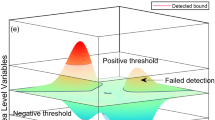Abstract
This study focuses on the spatial and temporal distribution characteristics of mesoscale eddies in the South China Sea (SCS). An automatic eddy detection method, based on the geometry of velocity vectors, was adopted to obtain an eddy dataset from 21 years of satellite altimeter data. Analysis revealed that the number of anticyclonic eddies was nearly equal to cyclonic eddies; in the SCS, cyclonic eddies are generally stronger than anticyclonic eddies and anticyclonic eddies are larger and longer-lived than cyclonic eddies. Anticyclonic eddies tend to survive longer in the spring and summer, while cyclonic eddies have longer lifetimes in the autumn and winter. The characteristics and seasonal variations of eddies in the SCS are strongly related to variations in general ocean circulation, in the homogeneity of surface wind stress, and in the unevenness of bottom topography in the SCS. The spatial and temporal variation of mesoscale eddies in the SCS could, therefore, be an important index for understanding local hydrodynamics and regional climate change.
Similar content being viewed by others
References
Chaigneau A, Gizolme A, Grados C. 2008. Mesoscale eddies off Peru in altimeter records: Identification algorithms and eddy spatio-temporal patterns. Prog. Oceanogr., 79 (2-4): 106–119, http://dx.doi.org/10.1016/j.pocean.2008.10.013.
Chelton D B, Schlax M G, Samelson R M, de Szoeke R A. 2007. Global observations of large oceanic eddies. Geophys. Res. Lett., 34 (15), http://dx.doi.org/10.1029/2007GL030812.
Chen G X, Gan J P, Xie Q, Chu X Q, Wang D X, Hou Y J. (2012. Eddy heat and salt transports in the South China Sea and their seasonal modulations. J. Geophys. Res., 117 (C5), http://dx.doi.org/10.1029/2011JC007724.
Chen G X, Hou Y J, Chu X Q. 2011. Mesoscale eddies in the South China Sea: mean properties, spatiotemporal variability, and impact on thermohaline structure. J. Geophys. Res., 116 (C6), http://dx.doi.org/10.1029/ 2010JC006716.
Cushman-Roisin B, Tang B Y, Chassignet E P. 1990. Westward motion of mesoscale eddies. J. Phys. Oceanogr., 20 (5): 758–768, http://dx.doi.org/10.1175/1520-0485(1990)020<0758:WMOME>2.0.CO;2.
Holte J, Straneo F, Moffat C, Weller R, Farrar J T. 2013. Structure and surface properties of eddies in the southeast Pacific Ocean. J. Geophys. Res.: Oceans, 118 (5): 2295–2309, http://dx.doi.org/10.1002/jgrc.20175.
Hu J Y, Gan J P, Sun Z Y, Zhu J, Dai M H. 2011. Observed three-dimensional structure of a cold eddy in the southwestern South China Sea. J. Geophys. Res., 116 (C5), http://dx.doi.org/10.1029/2010JC006810.
Hu J Y, Kawamura H, Hong H S, Qi Y Q. 2000. A review on the currents in the south china sea: seasonal circulation, South China sea warm current and Kuroshio intrusion. J. Oceanogr., 56 (6): 607–624, http://dx.doi.org/10.1023/A:1011117531252.
Hwang C, Chen S A. 2000. Circulations and eddies over the South China Sea derived from TOPEX/Poseidon altimetry. J. Geophys. Res., 105 (C10): 23 943–23 965, http://dx.doi.org/10.1029/2000JC900092.
Isern-Fontanet J, García-Ladona E, Font J. (2002. Identification of marine eddies from altimetric maps. J. Atmos. Ocean ic Tech nol., 20 (5): 772–778, http://dx.doi.org/10.1175/1520-0426(2003)20<772:IOMEFA>2.0.CO;2.
Lin X Y, Guan Y P, Liu Y. 2013. Three-dimensional structure and evolution process of Dongsha Cold Eddy during autum. 2000. J. Tropical Oceanogr., 32 (2): 55–65, http://dx.doi.org/10.3969/j.issn.1009-5470.2013.02.006.
Liu Y, Dong C M, Guan Y P, Chen D K, McWilliams J, Nencioli F. 2012. Eddy analysis in the subtropical zonal band of the North Pacific Ocean. Deep Sea Res. I: Ocean. Res. Paper., 68: 54–67, http://dx.doi.org/10.1016/j.dsr.2012.06.001.
McWilliams J C. 2008. The nature and consequences of oceanic eddies. In: Matthew W H, Hiroyasu H eds. Ocean Modeling in an Eddying Regime, Vol. 177 of Geophysical Monograph Series. American Geophysical Union, Washington DC, USA. p.5–15.
Morrow R, Birol F, Griffin D, Sudre J. (2004. Divergent pathways of cyclonic and anti-cyclonic ocean eddies. Geophys. Res. Lett., 31 (24), http://dx.doi.org/10.1029/2004gl020974.
Nencioli F, Dong C M, Dickey T, Washburn L, McWilliams J C. 2010. A vector geometry-based eddy detection algorithm and its application to a high-resolution numerical model product and high-frequency radar surface velocities in the southern California Bight. J. Atmos. Ocean ic Tech nol., 27 (3): 564–579, http://dx.doi.org/10.1175/2009jtecho725.1.
Penven P. 2005. Average circulation, seasonal cycle, and mesoscale dynamics of the Peru current system: a modeling approach. J. Geophys. Res., 110 (C10), http://dx.doi.org/10.1029/2005JC002945.
Pullen J, Doyle J D, May P, Chavanne C, Flament P, Arnone R A. 2008. Monsoon surges trigger oceanic eddy formation and propagation in the lee of the Philippine Islands. Geophys. Res. Lett., 35 (7), http://dx.doi.org/10.1029/2007GL033109.
Tajima T, Nakamura T. 2005. Experiments to study the betaeffect in atmospheric dynamics. Experiments in Fluids, 39 (3): 623–629, http://dx.doi.org/10.1007/s00348-005-1007-3.
Wang G H, Chen D K, Su J L. 2008. Winter eddy genesis in the eastern South China Sea due to orographic wind jets. J. Phys. Oceanogr., 38 (3):726–732, http://dx.doi.org/10.1175/2007JPO3868.1.
Wang G H. 2003. Mesoscale eddies in the South China Sea observed with altimeter data. Geophys. Res. Lett., 30 (21), http://dx.doi.org/10.1029/2003GL018532.
Xiu P, Chai F, Shi L, Xue H J, Chao Y. 2010. A census of eddy activities in the South China Sea during 1993–2007. J. Geophys. Res., 115 (C3), http://dx.doi.org/10.1029/2009JC005657.
Yang H Y, Wu L X, Liu H L, Yu Y Q. 2013. Eddy energy sources and sinks in the South China Sea. J. Geophys. Res., 118 (9): 4716–4726, http://dx.doi.org/10.1002/jgrc.20343.
Yi J, Du Y, He Z, Zhou C. 2014. Enhancing the accuracy of automatic eddy detection and the capability of recognizing the multi-core structures from maps of sea level anomaly. Ocean Science, 10 (1): 39–48, http://dx.doi.org/10.5194/os-10-39-2014.
Yuan D, Han W, Hu D. 2007. Anti-cyclonic eddies northwest of Luzon in summer-fall observed by satellite altimeters. Geophysical Research Letters, 34(13).
Author information
Authors and Affiliations
Corresponding author
Additional information
Supported by the National High Technology Research and Development Program of China (863 Program) (No. 2013AA09A505), the National Natural Science Foundation of China (No. U1133001), and the NSFC-Shandong Joint Fund for Marine Science Research Centers Grant (No. U1406401)
Rights and permissions
About this article
Cite this article
Xia, Q., Shen, H. Automatic detection of oceanic mesoscale eddies in the South China Sea. Chin. J. Ocean. Limnol. 33, 1334–1348 (2015). https://doi.org/10.1007/s00343-015-4354-9
Received:
Accepted:
Published:
Issue Date:
DOI: https://doi.org/10.1007/s00343-015-4354-9



